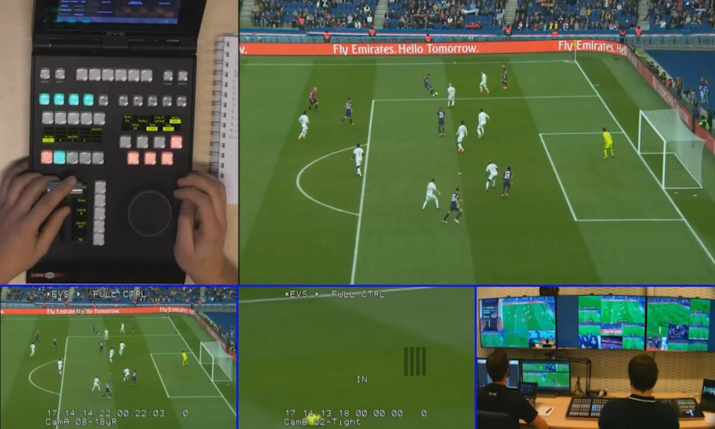Live production anywhere is the new reality for sports broadcasters

During SVG Europe Women’s The Art of Replay: EVS Live Sports Production Workshop, trainer Jamie Benning worked remotely from the UK with colleagues directing and replay operating in Belgium to demonstrate how EVS operators worked in a live sports setting
By Sébastien Verlaine, head of marketing and communications, EVS
This year has been challenging for everyone globally. The huge disruption the COVID-19 pandemic has caused in the industry has forced many broadcasters to rethink the way they produce their live sports events to better address the changes and uncertainties in the market.
With production teams working remotely, the spotlight has become focused on how to create more efficient workflows for the coverage of live events and how crews can collaborate more efficiently during this challenging time. And while the ability to produce an event from a distance is not new, it has gained momentum over the past few years and has become more relevant than ever since the COVID-19 pandemic. The way we enhance and make remote productions more efficient will only increase into 2021, with much of the world still facing restrictions.
Sports broadcasters today are challenged to produce more content, more efficiently, while coping with shrinking budgets. Traditional live production, as we’ve known it for many decades to be, with all primary equipment and staff located at the production site, is making way for alternative models to better adapt to the new realities of the industry.
At home and remote production
Before the pandemic, broadcasters were already using an at-home and remote production model which had many benefits, including reduced travel expenses since fewer people and less equipment are needed at a venue. Additionally, remote production means more events can be covered in a shorter period of time. By spending less time on the road, operators are able to produce back-to-back matches (perhaps even in the same day) or work on a wider variety of sports. This allows operators to rapidly gain new skills and experiences, leading to smoother, higher-quality productions.
When COVID-19 hit, broadcasters were thrown into the deep end of remote production. The travel restrictions and social distancing measures brought by the pandemic meant crews needed to be shifted away as much as possible from studios and centralised production facilities. Despite the little time they had to prepare, many broadcasters found new and creative ways to adapt their existing setups on the fly, allowing parts of their production crews to work from the safety of their own homes. By creating distributed remote workflows, organisations were able to continue producing and delivering content while helping contain the spread of the virus. Almost overnight, this ‘operator at home’ production model became the prevalent form of remote production, and the only way to get programmes back on air safely.
While newsrooms and talk shows have been able to adapt their formats and find solutions and workarounds to continue their programming with less disruption, sports productions have been among the most severely hit by the pandemic. The absence of live games has however given them the opportunity to take a step back and start rethinking their production models for the future.
Live production anywhere
For broadcasters, transitioning to remote production models hasn’t called for a complete overhaul of existing infrastructures. The core ingredients are there today to allow them to easily complement their current production setups to accommodate (or enhance) remote workflows while capitalising on their current investments.
By leveraging IP-based toolsets, software-defined technologies and cloud-based solutions, broadcasters can seamlessly move towards production models where location is no longer a constraint. At the end of the day, whether it’s REMI, GREMI, centralised, at home or distant remote, what broadcasters want to achieve is live production anywhere.
A live production is a highly collaborative process, and with crews becoming geographically dispersed, finding ways to facilitate content exchange between remote sites will be critical to help maintain the same level of efficiency in the production process. Broadcasters can make use of file accelerators, but also cloud integrations to enable users to access content from anywhere, for real-time collaboration and contribution. In this context, adding a layer of monitoring, that provides complete control and visibility of exchanged content is the key to streamlined distributed workflows.
What we can expect in 2021
The circumstances brought on by COVID-19 have led to widespread adoption of remote workflows, showing the entire industry that the remote way of working is a well and truly viable option. As we emerge from this pandemic, it will be important for broadcasters to take note of these recent achievements and make sure they make the right technology choices with business continuity in mind.
It’s safe to say that there are still a lot of unknowns when it comes to the pandemic and how it will continue to impact the broadcast industry and media companies. By further exposing the vulnerability of traditional approaches, the challenges brought by the pandemic have strengthened the idea that remote production will play a central role in the future of live production. As we head into 2021, we can expect to see improvements in today’s tools and technologies and an acceleration of innovations that will bring the future live remote production experience to the highest level, with crews collaborating live, from anywhere.
